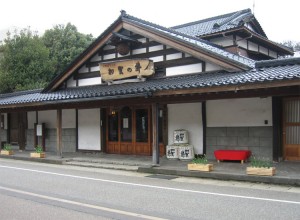Japanese food culture (2) 2015/9/6
Japan has been the only one civilized country who did not have livestock for foods. Thanks to rich circumstances, people in Japan have been able to get enough foods from woods, rivers and sea. At the same time, people have been trying their best to keep clean water and green woods in order to maintain such rich circumstances.
All of civilized countries destroyed or damaged natures to get foods, in other word, to expand agriculture. On the contrary, Japanese people have been keeping a nature in so good condition that they have been able to get enough food from a rich nature.
According to detailed analysis of Jomon remains( B.C.14500-B.C.1000), people there enjoyed wild grasses such as bracken, kudu vine, parsley, fern and variety of seafood such as clam, sardine, herring in spring.
In summer, they took mackerel, horse mackerel, snapper. And they took salmon, yellowtail, greenling and also many kinds of nuts such as chestnut, horse chestnut, acorn in autumn. In winter they took pheasant, copper pheasant, wild boar, venison.
Until now more than 60kinds of animals, 70 kinds of fishes, 350 kinds of shell fishes were discovered from Jomon remains which are scattered all over Japan.
It is a kind of hereditary from Jomon era that Japanese tend to take fresh seasonal food.
It is also a hereditary from Jomon era that Japanese tend to enjoy hot pot cooking.
Japanese archipelago is the only one area in the world where older than 10,000 years earthen vessels are discovered. The oldest one was as old as 16,500 years. It is presumed Jomon people started to boil grasses, nuts, meats and seafood for softening and preserving by using vessels.
It was a dramatic change in food culture history happened in early New Stone Age.
We can see such an interesting historical fact in modern Japanese unusual preference on various kinds of hot pot cooking.
Within wide range of Japanese foods, there is an apparent preference on raw food which requires freshness and cleanness, while on the other side there are a variety of foods which are made by aging for years.
There are many kinds of distinctive traditional seasonings such as soybean paste, soybean sauce, sweet rice wine and vinegar. All of them are essential for Japanese cuisine by adding delicate flavor and taste. All of these seasonings are made by aging with hereditary skillful techniques.
Together with these seasonings, many kinds of pickled vegetables and salted fishes form the basic platform for Japanese cuisine.
These seasonings and pickled foods are made from beautiful works by many kinds of koji molds and enzymes which can develop raw foods into more delicious, nonperishable and nutritious wonderful foods through aging and fermentation for long period.
It requires several months to age Japanese rice wine. It needs a few years to age soybean paste and vinegar. We can find the same aging technology in many salted foods such as distilled spirits, dried bonito and dried plum.
Sushi, made of salted fish and rice, originated from a preservative food to be carried by soldiers during a war.
It is a main characteristic of Japanese food culture that they develop all of these aged or pickled foods by cultivating and maintaining the most suitable condition for koji molds or enzymes to perform their very best for long period.
They take care of hereditary koji molds with the highest attention and treat molds warmly as their family even though they are not able to see figures of molds.
Above reminds us of Japanese traditional spiritual culture to worship Something Great in mountains or fields and appreciate Nature who cultivate various livings or, in other word, all kinds of foods.
It is critical to keep regular atmosphere and condition for molds which have decisive influence on quality of soybean paste or rice wine. Therefore there are many cellars for pastes or wines which are as old as few hundred years. This reminds us of one of important features of Japanese cultures, continuity.








